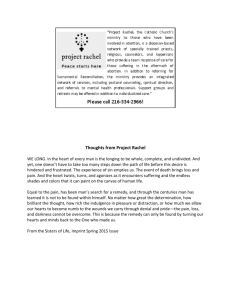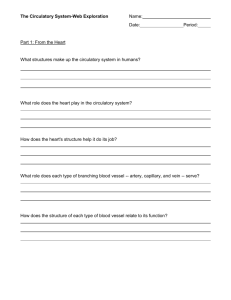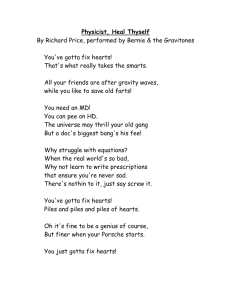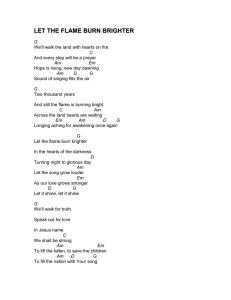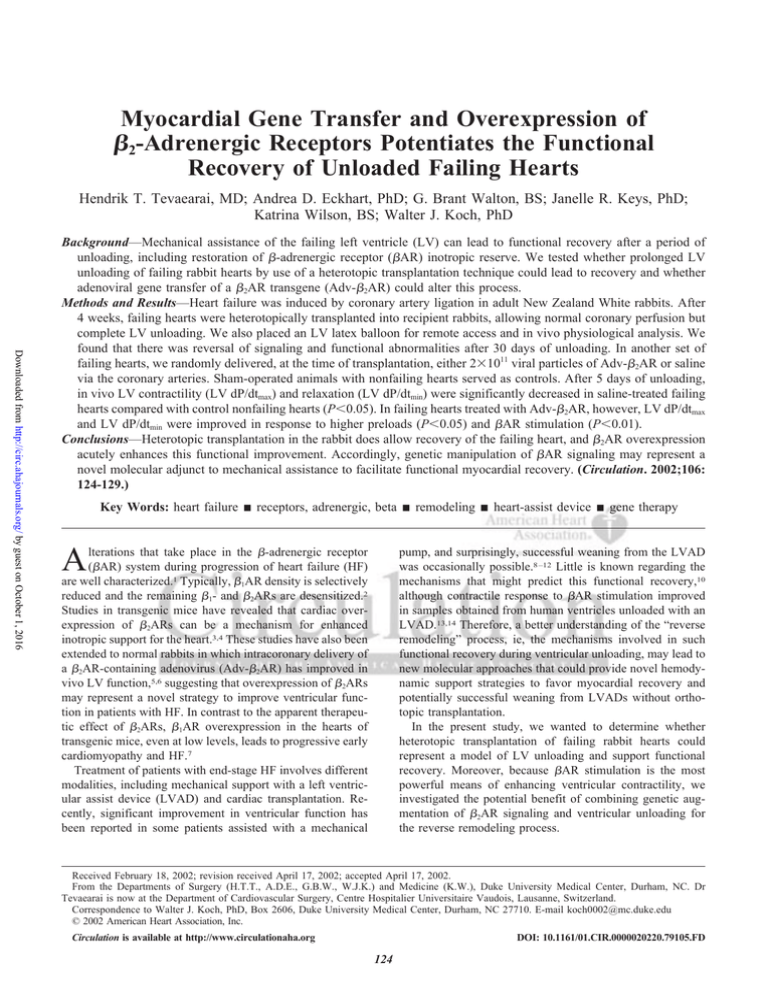
Myocardial Gene Transfer and Overexpression of
2-Adrenergic Receptors Potentiates the Functional
Recovery of Unloaded Failing Hearts
Hendrik T. Tevaearai, MD; Andrea D. Eckhart, PhD; G. Brant Walton, BS; Janelle R. Keys, PhD;
Katrina Wilson, BS; Walter J. Koch, PhD
Downloaded from http://circ.ahajournals.org/ by guest on October 1, 2016
Background—Mechanical assistance of the failing left ventricle (LV) can lead to functional recovery after a period of
unloading, including restoration of -adrenergic receptor (AR) inotropic reserve. We tested whether prolonged LV
unloading of failing rabbit hearts by use of a heterotopic transplantation technique could lead to recovery and whether
adenoviral gene transfer of a 2AR transgene (Adv-2AR) could alter this process.
Methods and Results—Heart failure was induced by coronary artery ligation in adult New Zealand White rabbits. After
4 weeks, failing hearts were heterotopically transplanted into recipient rabbits, allowing normal coronary perfusion but
complete LV unloading. We also placed an LV latex balloon for remote access and in vivo physiological analysis. We
found that there was reversal of signaling and functional abnormalities after 30 days of unloading. In another set of
failing hearts, we randomly delivered, at the time of transplantation, either 2⫻1011 viral particles of Adv-2AR or saline
via the coronary arteries. Sham-operated animals with nonfailing hearts served as controls. After 5 days of unloading,
in vivo LV contractility (LV dP/dtmax) and relaxation (LV dP/dtmin) were significantly decreased in saline-treated failing
hearts compared with control nonfailing hearts (P⬍0.05). In failing hearts treated with Adv-2AR, however, LV dP/dtmax
and LV dP/dtmin were improved in response to higher preloads (P⬍0.05) and AR stimulation (P⬍0.01).
Conclusions—Heterotopic transplantation in the rabbit does allow recovery of the failing heart, and 2AR overexpression
acutely enhances this functional improvement. Accordingly, genetic manipulation of AR signaling may represent a
novel molecular adjunct to mechanical assistance to facilitate functional myocardial recovery. (Circulation. 2002;106:
124-129.)
Key Words: heart failure 䡲 receptors, adrenergic, beta 䡲 remodeling 䡲 heart-assist device 䡲 gene therapy
lterations that take place in the -adrenergic receptor
(AR) system during progression of heart failure (HF)
are well characterized.1 Typically, 1AR density is selectively
reduced and the remaining 1- and 2ARs are desensitized.2
Studies in transgenic mice have revealed that cardiac overexpression of 2ARs can be a mechanism for enhanced
inotropic support for the heart.3,4 These studies have also been
extended to normal rabbits in which intracoronary delivery of
a 2AR-containing adenovirus (Adv-2AR) has improved in
vivo LV function,5,6 suggesting that overexpression of 2ARs
may represent a novel strategy to improve ventricular function in patients with HF. In contrast to the apparent therapeutic effect of 2ARs, 1AR overexpression in the hearts of
transgenic mice, even at low levels, leads to progressive early
cardiomyopathy and HF.7
Treatment of patients with end-stage HF involves different
modalities, including mechanical support with a left ventricular assist device (LVAD) and cardiac transplantation. Recently, significant improvement in ventricular function has
been reported in some patients assisted with a mechanical
A
pump, and surprisingly, successful weaning from the LVAD
was occasionally possible.8 –12 Little is known regarding the
mechanisms that might predict this functional recovery,10
although contractile response to AR stimulation improved
in samples obtained from human ventricles unloaded with an
LVAD.13,14 Therefore, a better understanding of the “reverse
remodeling” process, ie, the mechanisms involved in such
functional recovery during ventricular unloading, may lead to
new molecular approaches that could provide novel hemodynamic support strategies to favor myocardial recovery and
potentially successful weaning from LVADs without orthotopic transplantation.
In the present study, we wanted to determine whether
heterotopic transplantation of failing rabbit hearts could
represent a model of LV unloading and support functional
recovery. Moreover, because AR stimulation is the most
powerful means of enhancing ventricular contractility, we
investigated the potential benefit of combining genetic augmentation of 2AR signaling and ventricular unloading for
the reverse remodeling process.
Received February 18, 2002; revision received April 17, 2002; accepted April 17, 2002.
From the Departments of Surgery (H.T.T., A.D.E., G.B.W., W.J.K.) and Medicine (K.W.), Duke University Medical Center, Durham, NC. Dr
Tevaearai is now at the Department of Cardiovascular Surgery, Centre Hospitalier Universitaire Vaudois, Lausanne, Switzerland.
Correspondence to Walter J. Koch, PhD, Box 2606, Duke University Medical Center, Durham, NC 27710. E-mail koch0002@mc.duke.edu
© 2002 American Heart Association, Inc.
Circulation is available at http://www.circulationaha.org
DOI: 10.1161/01.CIR.0000020220.79105.FD
124
Tevaearai et al
TABLE 1. Comparison of LV dP/dtmax, LV dP/dtmin, and LV
Systolic Pressure in Failing (4 Weeks Post-MI) or Control (4
Weeks Post-Sham) Hearts at Day 1 After Transplantation
HF (n⫽10)
Control Hearts (n⫽7)
LV dP/dtmax, mm Hg/s
Baseline
⫹0.3 mL
ISO⫹0.3 mL
707.5⫾83.8*
986.8⫾93.8
810.0⫾99.3†
1342.2⫾99.2
1200.6⫾134.7†
2075.6⫾203.4
LV dP/dtmin, mm Hg/s
Baseline
⫹0.3 mL
ISO⫹0.3 mL
⫺718.6⫾67.7*
⫺945.7⫾102.9
⫺853.2⫾88.8†
⫺1302.3⫾74.4
⫺1208.7⫾138.3†
⫺1916.1⫾151.6
LV systolic pressure, mm Hg
Baseline
42.8⫾2.9
50.9⫾5.6
⫹0.3 mL
70.0⫾5.2*
86.3⫾7.6
ISO⫹0.3 mL
78.8⫾7.0*
108.8⫾10.8
Gene Therapy and Cardiac Unloading
125
were lightly anesthetized, and the extremity of the tubing was
retrieved and connected to a Y-connector that allowed adjustment of
the LV end-diastolic volume from one port and the introduction of a
high-fidelity pressure transducer (Millar Instruments) through the
other port. Baseline LV end-diastolic volume was normalized to a
balloon volume providing an end-diastolic pressure of 0 mm Hg. LV
function was assessed at days 1, 3, and 5 under 2 different preload
conditions (baseline and ⫹0.3 mL). Response to AR stimulation
was assessed by an intravenous infusion of 0.1 g · kg⫺1 · min⫺1
isoproterenol (ISO). At day 5, animals were euthanized, and infarction size was calculated as a percentage of the entire free wall as
described.17 In a separate group of animals, longer-term effects of
unloading were also examined by measurement of LV function every
5 days until day 30.
Determination of Myocardial AR Density
Cardiac sarcolemmal membranes were prepared and total AR
density was determined as previously described.3,5
Statistical Analysis
Data are expressed as mean⫾SEM. Paired Student’s t tests were
used for comparison of AR density before and after transplantation.
Downloaded from http://circ.ahajournals.org/ by guest on October 1, 2016
Baseline represents conditions in which the LV balloon and volume was
adjusted to an LV end-diastolic pressure of 0 mm Hg; ⫹0.3 mL, a volume of
0.3 mL; and ISO⫹0.3 mL, both ISO (0.1 g 䡠 kg⫺1 䡠 min⫺1) and a 0.3 mL
increased preload.
*P⬍0.05, †P⬍0.005 vs control hearts.
Methods
Adenoviral Transgenes
We used a first-generation E1/E3-deleted replication-deficient serotype 5 adenovirus as previously described.5,15 The 2AR transgene
(Adv-2AR) and the marker transgene -galactosidase (Adv-Gal)
were driven by the cytomegalovirus promoter. Virus was thawed and
mixed with PBS to a final volume of 2 mL immediately before use.
Induction of HF
Adult male New Zealand White rabbits (3 kg) were used, and all
procedures were performed in accordance with the regulations
adopted by the National Institutes of Health and approved by the
Animal Care and Use Committee of Duke University. A myocardial
infarction (MI) was induced by a ligation of the first marginal branch
of the left circumflex coronary artery as previously described.16,17
The control group included sham-operated animals in which only a
thoracotomy and pericardiotomy were performed.
Heterotopic Transplantation and Gene Delivery
Four weeks after left circumflex coronary artery ligation, donor
animals were anesthetized with ketamine (60 mg/kg) and acepromazine (1.0 mg/kg) and ventilated. The hearts were exposed via a
clam-shell thoracic incision. HF was confirmed by global dilation of
the heart, the presence of pleural effusion and/or ascites, and the
presence of a large infarcted area estimated to be ⱖ30% of the LV
free wall. The donor hearts were then arrested by intracoronary
perfusion with 30 mL of University of Wisconsin cold cardioplegic
solution and quickly harvested and maintained at 4°C as described.18,19 Explanted hearts were randomized to receive either
adenovirus or PBS. The hearts were then transplanted into the neck
of recipient rabbits as described.18 Total ischemic time was ⬇45
minutes. The hearts resumed vigorous contraction within 3 minutes
of reperfusion. Dexamethasone (4 mg/kg) was administered intravenously before reperfusion and then intramuscularly on a daily basis.
In a subgroup, an LV biopsy was taken from the donor heart for
biochemical comparison with paired samples obtained 5 days after
unloading.
LV Functional Assessment
In another subgroup of experiments, we positioned an LV latex
balloon into the left atrium connected to tubing conducted under the
skin to the subscapular region. To measure cardiac function, animals
Figure 1. Progression of LV recovery over a 30-day period of
unloading of failing hearts (4 weeks after MI, n⫽5). A, LV contractility (LV dP/dtmax). B, LV relaxation (LV dP/dtmin). Basal conditions were defined as the LV end-diastolic volume necessary
to generate an LV end-diastolic pressure of 0 mm Hg. Basal
function (䉫) did not improve over the 30-day unloading period
(*P⫽NS; 1-way ANOVA for repeated measures). Response to a
perfusion of 0.1 g · kg⫺1 · min⫺1 ISO (‘) improved slightly over
time (†P⬍0.05 for LV dP/dtmax, P⫽NS for LV dP/dtmin). The function in loaded LV (basal⫹0.3 mL end-diastolic volume) improved
significantly over time (▫; ‡P⬍0.05 for LV dP/dtmax, P⬍0.01 for
LV dP/dtmin). ISO stimulation (0.1 g · kg⫺1 · min⫺1) of loaded LV
(basal⫹0.3 mL end-diastolic volume) improved to the greatest
extent over the 30-day period of LV unloading (䡲; §P⬍0.001 for
LV dP/dtmax and for LV dP/dtmin). Txp indicates transplantation.
126
Circulation
July 2, 2002
One-way and 2-way ANOVAs were used to compare LV function in
transplanted hearts. For all tests, a value of P⬍0.05 was considered
significant.
Results
Assessment of HF
Downloaded from http://circ.ahajournals.org/ by guest on October 1, 2016
A total of 42 rabbit hearts were successfully transplanted into
the neck of recipient animals and studied regularly until
euthanization at day 5 or day 30. Hearts with an infarct size
estimated to be ⬍30% of the LV free wall (at the time of
death) and that were not accompanied by ascites and/or
pleural effusion were not considered for transplantation.
Importantly, no significant difference in infarct size was
observed between MI hearts that received Adv-2AR
(35.0⫾2.3% of the LV free wall, n⫽4) and MI hearts treated
with PBS (38.9⫾1.9%; n⫽6, P⫽NS).
In vivo LV hemodynamics was measured in 4-week
post-MI hearts via the inserted latex balloon at day 1 after
transplantation. This function 24 hours after transplant allowed the effect of cardioplegic arrest and surgery to become
less important.19,20 All indices of LV function were significantly decreased compared with the function of shamoperated transplanted hearts (n⫽7), confirming that these
hearts were in HF (Table 1).
increased preload and ISO provided the highest improvement
over the 30 days of ventricular unloading (Figure 1).
Restoration of AR Density in Unloaded
Failing Ventricles
As in other models of HF, AR density in LV biopsies
obtained at the time of transplantation of the failing hearts
(post-MI) was decreased (31.8⫾2.6 fmol/mg protein, n⫽6)
compared with control (sham) (46.4⫾2.2 fmol/mg protein,
n⫽4, P⬍0.005) (Figure 2). Interestingly, AR density was
restored to normal levels (48.1⫾3.3 fmol/mg protein, n⫽6,
P⬍0.0005 versus pretransplantation) in membranes purified
from the same failing hearts after 5 days of unloading via
heterotopic transplantation (Figure 2).
Transgene Expression
Five days after ex vivo delivery of 2⫻1011 total viral particles
(TVP) of Adv-Gal, the transgene was robustly expressed in
the transplanted heart, as confirmed by histological galactosidase staining (Figure 3A). Expression of Adv-2AR was
dose-dependent, and both 1⫻1011 (1⫻) and 2⫻1011 (2⫻)
TVP significantly increased AR density, with the 2⫻ dose
Functional Recovery of Unloaded (Transplanted)
Failing Hearts
We tested whether chronic unloading via heterotopic transplantation could lead to reversal of LV dysfunction. To aid
against rejection,18 we treated rabbits with a daily dose of
dexamethasone, and LV function was assessed every 5 days
until day 30 after surgery. Basal LV function did not change
over the 30-day period of unloading in hearts transplanted 4
weeks after MI. In post-MI hearts, however, both LV contractility (LV dP/dtmax) and relaxation (LV dP/dtmin) progressively increased after ISO stimulation during the 4 weeks of
unloading (Figure 1). Moreover, the response to an increased
preload also improved in these failing hearts during the 30
days of unloading, and interestingly, the combination of both
Figure 2. Comparison of AR density in membrane (mb) preparations obtained from LV before heterotopic transplantation (preTxp) and 5 days after LV unloading (post-Txp) in normal (▫;
n⫽4) and failing (䡲, n⫽6) hearts. In normal hearts, AR density
increased from 46.4⫾2.2 to 55.8⫾2.7 fmol/mg mb protein
(*P⬍0.05). AR density was decreased significantly in failing
hearts before transplantation (31.8⫾2.6 fmol/mg mb protein;
†P⫽0.002) but increased to 48.1⫾3.3 fmol/mg mb protein after
5 days of unloading (‡P⬍0.0001), which was similar to normal
unloaded hearts (§P⫽NS).
Figure 3. Myocardial transgene expression 5 days after cardiac
heterotopic transplantation (Txp) and intracoronary gene delivery. A, -Gal staining in a representative normal LV 5 days after
Txp and delivery of 2⫻1011 TVP of Adv-Gal. B, AR density in
membrane (mb) preparation obtained from Txp failing hearts
and comparison between 3 doses of Adv-2AR: 0.3⫻1011 TVP
(n⫽6), 1⫻1011 TVP (n⫽3), and 2⫻1011 TVP (n⫽4). Control hearts
received PBS only (n⫽6). *P⬍0.001 vs control.
Tevaearai et al
Gene Therapy and Cardiac Unloading
127
TABLE 2. Comparison of LV dP/dtmax, LV dP/dtmin, and LV Systolic Pressure 5 Days After LV Unloading Between Failing Hearts (4
Weeks Post-MI) That Received Either PBS (HFⴙPBS) or Adv-2AR (HFⴙAR) at the Time of Transplantation, and Control Hearts (4
Weeks Post-Sham) That Received PBS (Control HeartsⴙPBS)
HF⫹AR (n⫽4)
HF⫹PBS (n⫽6)
Day 1
Day 5
Day 1
Control Hearts⫹PBS (n⫽7)
Day 5
Day 1
Day 5
LV dP/dtmax
Baseline
678.5⫾97.2
849.3⫾120.8
909.5⫾170.0
1349.1⫾377.8
986.8⫾93.8
1527.4⫾142.4†
⫹0.3 mL
806.6⫾122.7
935.0⫾139.0
1021.3⫾218.2
2224.8⫾449.0*
1342.2⫾99.2
2289.8⫾135.3‡
1253.5⫾169.6
1350.1⫾175.5
1548.2⫾409.5
2652.6⫾393.9*
2075.6⫾203.4
3230.5⫾222.8‡
ISO⫹0.3 mL
LV dP/dtmin
Baseline
⫺652.3⫾74.4
⫺764.3⫾93.5
⫺942.8⫾109.9
⫺1157.0⫾233.7
⫹0.3 mL
⫺834.1⫾104.8
⫺892.3⫾126.9
⫺1026.1⫾170.4
⫺1623.7⫾271.0*
⫺1302.3⫾74.4
⫺1879.0⫾70.7‡
⫺1257.4⫾180.5
⫺1203.7⫾153.2
⫺1459.6⫾362.2
⫺1965.5⫾229.2*
⫺1916.1⫾151.6
⫺2457.4⫾115.9‡
ISO⫹0.3 mL
⫺945.7⫾102.9
⫺1218.1⫾95.7†
LV systolic pressure
Downloaded from http://circ.ahajournals.org/ by guest on October 1, 2016
Baseline
41.5⫾3.8
45.7⫾3.6
53.1⫾7.3
68.4⫾15.1
50.9⫾5.6
76.1⫾6.8†
⫹0.3 mL
65.4⫾6.8
68.9⫾6.5
85.5⫾7.9
139.0⫾14.8†
86.3⫾7.6
149.5⫾9.6‡
ISO⫹0.3 mL
75.7⫾10.6
77.7⫾10.4
103.5⫾17.1
158.1⫾16.7†
108.8⫾10.8
163.7⫾8.5‡
Conditions and units are identical to Table 1.
*P⬍0.05, †P⬍0.01, ‡P⬍0.001 vs group of HF⫹PBS.
increasing it to 511.6⫾101.5 fmol/mg membrane protein
(n⫽4). This represents ⬎8 times the value measured in
control hearts (Figure 3B; P⬍0.005). Accordingly, we used
2⫻1011 TVP as our unloaded heart dose.
2AR Gene Transfer Improves Functional
Recovery of Unloaded Failing Hearts
Although baseline function did not differ significantly between failing hearts that received the 2AR transgene (n⫽4)
and those that received PBS (n⫽6), we found an improved
response to mechanical stimulation when we increased preload to 0.3 mL above baseline volume (P⬍0.05, Table 2 and
Figure 4). We also observed a significant functional improvement in response to AR stimulation after 5 days of LV
unloading (P⬍0.05, Table 2 and Figure 4). Moreover, maximal LV pressure generated during systole was significantly
increased in unloaded failing hearts previously treated with
Adv-2AR compared with those that received PBS
(P⬍0.005, Figure 5). In fact, functional response to ISO
stimulation was virtually identical to that obtained from
nonfailing (sham, n⫽7) unloaded hearts (Figure 5B).
density significantly increased in unloaded hearts compared
with nontransplanted hearts, whereas no difference was
observed in transplanted hearts in which the LV balloon was
kept inflated (Figure 6B). Thus, restoration of AR density as
well as functional improvement appears to be due to mechanical unloading rather than denervation.
Discussion
In the present study, we used the heterotopic transplantation
model to simulate ventricular unloading. Using this model,
we were able to reproduce the functional improvements
observed in human failing hearts unloaded by use of an
LVAD. Moreover, we demonstrate the benefit of gene-
Restoration of AR Density Is Independent of
Cardiac Denervation
Because the transplantation technique renders the grafted
heart denervated, restoration of AR density might be a result
of the absence of direct neural stimulation rather than
unloading. To test this, we compared the function of normal
transplanted hearts in which the LV balloon was kept inflated
to maintain LV loading with that of unloaded transplanted
normal hearts in which the balloon was deflated, except for
data recordings at day 1 and day 5. Although no baseline
difference was observed between loaded and unloaded hearts
after 5 days, both AR and preload-induced function progressively improved in unloaded hearts, whereas no change
occurred in loaded hearts (Figure 6A). In addition, AR
Figure 4. Comparison of contractility between day 1 (▫) and day
5 (䡲) after heterotopic transplantation of normal hearts (Ct; n⫽7),
failing hearts treated by transplantation and treated with Adv2AR (HF⫹; n⫽4), and failing transplanted hearts that received
PBS (HF; n⫽6). Shown is contractility at baseline (LV end-diastolic pressure⫽0 mm Hg), to increased preload conditions
(⫹0.3 mL), and after AR stimulation with 0.1 g · kg⫺1 · min⫺1
ISO, and under a combination (ISO⫹0.3 mL). Results are
expressed as percentage of the basal value measured at
day 1 after transplantation. *P⫽NS, †P⬍0.05, ‡P⬍0.01 (day 5
vs day 1).
128
Circulation
July 2, 2002
Downloaded from http://circ.ahajournals.org/ by guest on October 1, 2016
Figure 5. LV systolic maximal pressure (5 days after transplantation) in response to increased preload conditions and (A) without or (B) with ISO stimulation (0.1 g · kg⫺1 · min⫺1) in normal
hearts (‚; n⫽7) and failing hearts that received Adv-2AR (䡲;
n⫽4) or PBS (»; n⫽6). *P⬍0.05, †P⬍0.005 (Adv-2AR vs PBS).
‡P⫽NS (ANOVA, Adv-2AR transplanted hearts vs normal transplanted hearts).
mediated modulation of 2ARs to restore functional response
to AR stimulation as well as to increased preload. Thus, our
data indicate that it may be advantageous to combine mechanical unloading with a molecular therapeutic modality to
hasten and enhance myocardial functional recovery. As
described previously, not all patients may recover sufficient
ventricular strength to allow weaning from their LVAD8 –12
and prolonged recovery of their myocardial contractile function.21 In the present study, failing hearts required 1 month of
unloading after a large LV infarction before we were able to
measure functional improvement. In contrast, failing hearts
that received intracoronary Adv-2AR demonstrated significant LV functional improvement within the first week of
ventricular unloading. Thus, Adv-2AR gene therapy to the
unloaded failing heart may represent a novel form of “molecular assistance” to provide beneficial synergy to mechanical assistance.
Previous reports have suggested a role for AR signaling
in the reverse remodeling process that occurs in mechanically
assisted failing hearts.13,14 For example, response to AR
stimulation was increased in human myocytes isolated from
hearts unloaded with an LVAD.13,14 In the present study,
AR density was increased in normal hearts 5 days after
heterotopic transplantation, and we verified that these
changes were independent of denervation. Five days was not
sufficient, however, to permit any significant functional
improvement due to unloading. Importantly, overexpression
of 2ARs to ⬇8-fold over normal via adenovirus-mediated
Figure 6. Contractility and AR density in chronically loaded
and unloaded control transplanted hearts. A, LV dP/dtmax and LV
dP/dtmin of normal hearts 5 days after transplantation. Comparison is made between unloaded (▫; n⫽5) and loaded (䡲; n⫽3)
hearts as described in the text. B, AR density in these loaded
(n⫽3) vs unloaded (n⫽3) transplanted hearts. Values are
expressed as percentage of a control group of normal nontransplanted hearts (n⫽3). *P⬍0.005 (unloaded hearts vs control nontransplanted hearts). †P⫽NS (loaded hearts vs control nontransplanted hearts).
2AR gene delivery at the time of transplantation was
accompanied by significant increases in both contractility and
relaxation in response to preload and AR agonist stimulation within just 5 days. Thus, manipulation of 2AR signaling
appears to be able to play a critical role in the reverse
remodeling process by triggering functional recovery of
unloaded failing hearts.
It is noteworthy that in transgenic mice, cardiac overexpression
of 2ARs at extraordinary high levels (⬎150-fold) was associated
with cardiomyopathy, whereas cardiac 2AR overexpression to up
to ⬇100-fold showed no pathology.3,4 These studies in transgenic
Tevaearai et al
Downloaded from http://circ.ahajournals.org/ by guest on October 1, 2016
mice led to the hypothesis that 2AR overexpression would be
beneficial in HF. Indeed, 2AR gene delivery to normal rabbit
hearts also enhanced function, although 2AR overexpression was
much lower.5,6 Moreover, 2AR overexpression, at levels seen in
the present study, in cultured failing rabbit cardiomyocytes did
improve abnormal AR signaling; however, functional indices
were not measured. Importantly, actual treatment of a failing heart
with 2AR gene transfer, such as in the present study, has not
previously been performed. In this study as well as in our previous
adenovirus-mediated gene delivery studies, we have not seen
cardiac 2AR overexpression exceed ⬇15-fold.5,6 Thus, we do not
believe that this methodology would lead to “toxic” levels of 2AR
overexpression, but importantly, we appear to be able to achieve
“therapeutic” levels of 2ARs in the heart.
It is important to note the appreciation that signaling
through 1ARs and 2ARs are qualitatively and quantitatively
different, which was reviewed recently.22 In contrast to the
beneficial cardiac effects after 2AR overexpression (up to
100-fold), transgenic overexpression of 1ARs in the mouse
heart even at low levels (15- to 30-fold) produces significant
pathology, including cardiomyopathy and HF. Moreover,
some data indicate that these 2 AR subtypes can exhibit
opposing effects in the heart, including the induction of
apoptosis.22 Thus, as this study indicates, selective enhancement of 2AR signaling may be therapeutic in the failing
heart, because we have shown that 2AR overexpression can
hasten the functional recovery of unloaded failing hearts.
This study does present some limitations. We did not
specifically address the arrhythmic activity in the transplanted hearts that may be expected after 2AR overexpression. Another concern in the interpretation of these results is
immune rejection, although no significant signs of immune
rejection were detected after 5 days of transplantation. Inflammatory reactions might trigger adverse reactions that
could also influence the interactions between reverse remodeling, adenovirus-mediated modification of genetic expression, and subsequent functional changes. In addition, the
nature of adenoviruses is such that they allow gene expression for a limited period of time and therefore may not be
appropriate for long-term studies of reverse remodeling. This
could be an advantage, however, because permanent overexpression may be deleterious after adequate functional recovery is achieved. Finally, in this model of unloading, the
failing heart is removed from its environment and placed into
a healthy recipient. Although we demonstrated that functional
and AR density recoveries were independent of cardiac
denervation, other humoral molecules present in the HF
patient may influence ventricular remodeling.
Nevertheless, our study clearly demonstrates the potential usefulness of 2AR augmentation to aid in the reverse remodeling
process that occurs in unloaded hearts, because this may represent a
beneficial molecular adjunct to mechanical unloading to improve
functional recovery of severely dysfunctional hearts. Moreover, our
study demonstrates that heterotopic transplantation can reasonably
assimilate mechanical unloading and may thus represent a suitable
model to study the functional and biochemical effects of adjunct
therapeutic modalities.
Gene Therapy and Cardiac Unloading
129
Acknowledgments
This work was supported by grants from the Swiss National Science
Foundation 84NP-057501 and 32-65044.01 (Dr Tevaearai), National
Institutes of Health grants HL-59533 (Dr Koch) and HL-56205 (Dr
Koch), and a medical student research fellowship from Howard
Hughes Medical Institute (G.B. Walton).
References
1. Brodde OE. Beta-adrenoceptors in cardiac disease. Pharmacol Ther.
1993;60:405– 430.
2. Bristow MR, Hershberger RE, Port JD, et al. 1 and 2 adrenergic
receptor mediated adenylate cyclase stimulation in nonfailing and failing
human ventricular myocardium. Mol Pharmacol. 1989;35:295–303.
3. Milano CA, Allen LF, Rockman HA, et al. Enhanced myocardial function
in transgenic mice overexpressing the 2-adrenergic receptor. Science.
1994;264:582–586.
4. Liggett SB, Tepe NM, Lorenz JN, et al. Early and delayed consequences
of 2-adrenergic receptor overexpression in mouse hearts: critical role for
expression level. Circulation. 2000;101:1707–1714.
5. Maurice JP, Hata JA, Shah AS, et al. Enhancement of cardiac function
after adenoviral-mediated in vivo intracoronary 2-adrenergic receptor
gene delivery. J Clin Invest. 1999;104:21–29.
6. Shah AS, Lilly RE, Kypson AP, et al. Intracoronary adenovirus-mediated
delivery and overexpression of the 2-adrenergic receptor in the heart: prospects
for molecular ventricular assistance. Circulation. 2000;101:408–414.
7. Engelhardt S, Hein L, Wiesmann F, et al. Progressive hypertrophy and
heart failure in 1- adrenergic receptor transgenic mice. Proc Natl Acad
Sci U S A. 1999;96:7059 –7064.
8. Frazier OH, Benedict CR, Radovancevic B, et al. Improved left ventricular function after chronic left ventricular unloading. Ann Thorac Surg.
1996;62:675– 682.
9. Müller J, Wallakut G, Weng Y, et al. Weaning from mechanical support
after complete recovery in patients with idiopathic dilated cardiomyopathy. In: Hetzer R, Hennig E, Loebe M, eds. Mechanical Circulatory
Support. Berlin: Springer; 1997; 93:107.
10. Mancini DM, Beniaminovitz A, Levin H, et al. Low incidence of myocardial recovery after left ventricular assist device implantation in patients
with chronic heart failure. Circulation. 1998;98:2383–2389.
11. Pietsch L, Laube H, Baumann G, et al. Recovery from end-stage ischemic
cardiomyopathy during long-term LVAD support. Ann Thorac Surg.
1998;66:555–557.
12. Hetzer R, Müller J, Weng Y, et al. Cardiac recovery in dilated cardiomyopathy by unloading with a left ventricular assist device. Ann Thorac
Surg. 1999;68:742–749.
13. Dipla K, Mattiello JA, Jeevanandam V, et al. Myocyte recovery after
mechanical circulatory support in humans with end-stage heart failure.
Circulation. 1998;97:2316 –2322.
14. Heerdt PM, Holmes JW, Cai B, et al. Chronic unloading by left ventricular assist device reverses contractile dysfunction and alters gene
expression in end-stage heart failure. Circulation. 2000;102:2713–2719.
15. Akhter SA, Skaer CA, Kypson AP, et al. Restoration of -adrenergic
signaling in failing cardiac ventricular myocytes via adenoviral-mediated
gene transfer. Proc Natl Acad Sci U S A. 1997;94:12100 –12105.
16. Maurice JP, Shah AS, Kypson AP, et al. Molecular -adrenergic signaling abnormalities in failing rabbit hearts after infarction. Am J Physiol.
1999;276:H1853–H1860.
17. White DC, Hata JA, Shah AS, et al. Preservation of myocardial -adrenergic
receptor signaling delays the development of heart failure following myocardial
infarction. Proc Natl Acad Sci U S A. 2000;97:5428–5433.
18. Shah AS, White DC, Tai O, et al. Adenovirus-mediated genetic manipulation of the myocardial -adrenergic signaling system in transplanted
hearts. J Thorac Cardiovasc Surg. 2000;120:581–588.
19. Tevaearai HT, Eckhart AD, Shotwell KF, et al. Ventricular dysfunction after
cardioplegic arrest is improved after myocardial gene transfer of a -adrenergic
receptor kinase inhibitor. Circulation. 2001;104:2069–2074.
20. DiSesa VJ. Pharmacologic support for postoperative low cardiac output.
Semin Thorac Cardiovasc Surg. 1991;3:13–23.
21. Hetzer R, Muller JH, Weng YG, et al. Midterm follow-up of patients who
underwent removal of a left ventricular assist device after cardiac
recovery from end-stage cardiomyopathy. J Thorac Cardiovasc Surg.
2000;120:843– 853.
22. Rockman HA, Koch WJ, Lefkowitz RJ. Seven membrane spanning
receptors and heart function. Nature. 2002;415:206 –212.
Myocardial Gene Transfer and Overexpression of ß2-Adrenergic Receptors Potentiates
the Functional Recovery of Unloaded Failing Hearts
Hendrik T. Tevaearai, Andrea D. Eckhart, G. Brant Walton, Janelle R. Keys, Katrina Wilson
and Walter J. Koch
Downloaded from http://circ.ahajournals.org/ by guest on October 1, 2016
Circulation. published online June 17, 2002;
Circulation is published by the American Heart Association, 7272 Greenville Avenue, Dallas, TX 75231
Copyright © 2002 American Heart Association, Inc. All rights reserved.
Print ISSN: 0009-7322. Online ISSN: 1524-4539
The online version of this article, along with updated information and services, is located on the
World Wide Web at:
http://circ.ahajournals.org/content/early/2002/06/17/01.CIR.0000020220.79105.FD.citation
Permissions: Requests for permissions to reproduce figures, tables, or portions of articles originally published
in Circulation can be obtained via RightsLink, a service of the Copyright Clearance Center, not the Editorial
Office. Once the online version of the published article for which permission is being requested is located,
click Request Permissions in the middle column of the Web page under Services. Further information about
this process is available in the Permissions and Rights Question and Answer document.
Reprints: Information about reprints can be found online at:
http://www.lww.com/reprints
Subscriptions: Information about subscribing to Circulation is online at:
http://circ.ahajournals.org//subscriptions/


